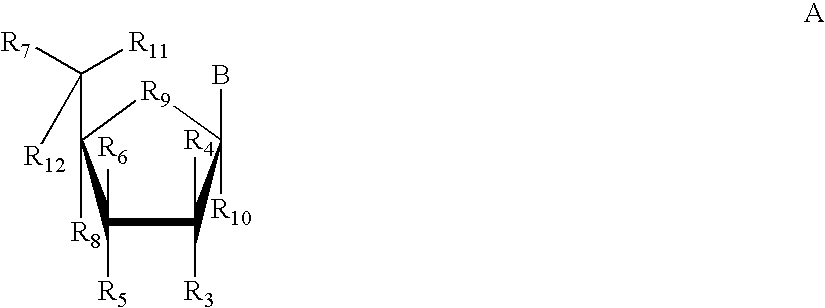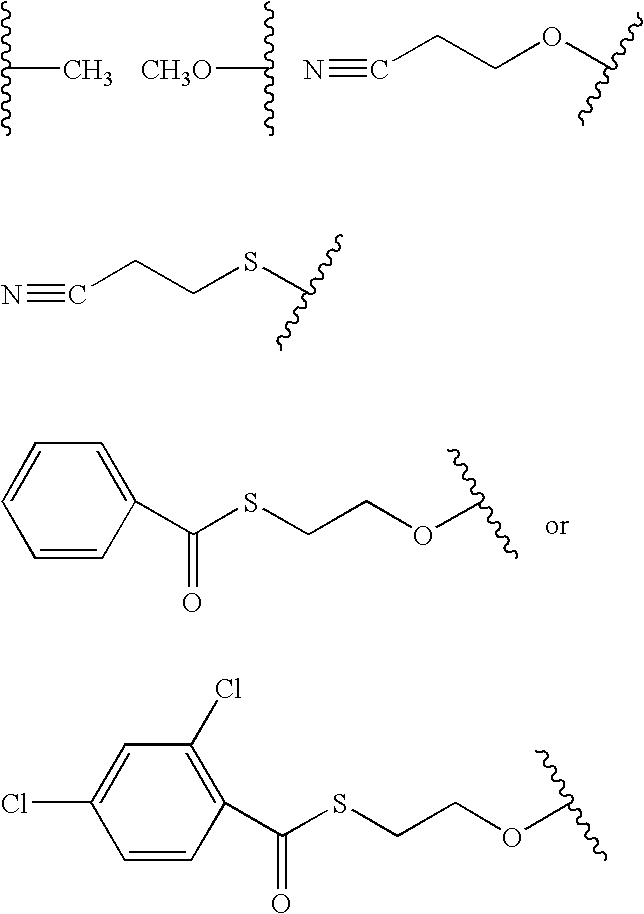Fluoroalkoxy, nucleosides, nucleotides, and polynucleotides
a technology of fluoroalkoxy and nucleosides, applied in the field of fluoroalkoxy nucleosides, nucleotides, and polynucleotides, can solve the problems of limiting the use of native polynucleotides, and limiting the use of non-modified rna polynucleotides in vivo applications
- Summary
- Abstract
- Description
- Claims
- Application Information
AI Technical Summary
Benefits of technology
Problems solved by technology
Method used
Image
Examples
example 1
Synthesis of Fluoroalkoxy Nucleoside Phosphoroamidites N-ACETYL-3′,5′-O-TIPDS-CYTIDINE (2), FIG. 1
[0466] N-Acetyl Cytidine (20.0 g, mmol) was weighed into a 1 L round bottomed flask and co-evaporated with pyridine. The flask was fitted with a stir bar and septum, flushed with argon and charged with pyridine. 1,3-Dichloro-(1,1,3,3-Tetrawasopropyl)-1,3-disiloxane (24.32 g, 1.1 equiv.) was weighed out in a polypropylene syringe and added, dropwwase to the stirring reaction mixture which was then allowed to stir overnight. Pyridine was removed in vacuo from the reaction mixture and the resultant solids were dissolved in DCM (500 mL). The DCM solution was washed with saturated bicarbonate (2×500 mL). The organic phase was dried over Na2SO4 and filtered. The solvent was removed to give 41.05 g of a white foam that was used crude (theoretical yield 37.01 g). 1H NMR (400 MHz, DMSO-d6) δ 10.85 (s, 1H); 8.09 (d, J=7.4 Hz, 1H), 7.17 (d, J=7.4 Hz, 1H), 5.74 (s, 1H), 5.58 (s, 1H), 4.19 (d, J=13....
example 2
Activity of Fluoroalkoxy Modified siNA Constructs in Mammalian Cells
[0477] 2′-OCF3 modified siNA constructs (see Table III) were synthesized via solid phase oligonucleotide synthesis using the methods described herein and were tested in cell culture assays. The human hepatocellular carcinoma cell line Hep G2 was grown in Dulbecco's modified Eagle media supplemented with 10% fetal calf serum, 2 mM glutamine, 0.1 mM nonessential amino acids, 1 mM sodium pyruvate, 25 mM Hepes, 100 units penicillin, and 100 μg / ml streptomycin. To generate a replication competent cDNA, prior to transfection the HBV genomic sequences are excised from the bacterial plasmid sequence contained in the psHBV-1 vector. This was done with an EcoRI and Hind III restriction digest. Following completion of the digest, a ligation was performed under dilute conditions (20 μg / ml) to favor intermolecular ligation. The total ligation mixture was then concentrated using Qiagen spin columns.
[0478] Transfection of the hu...
example 3
Tandem Synthesis of siNA Constructs
[0479] Exemplary siNA molecules of the invention are synthesized in tandem using a cleavable linker, for example, a succinyl-based linker. Tandem synthesis as described herein is followed by a one-step purification process that provides RNAi molecules in high yield. This approach is highly amenable to siNA synthesis in support of high throughput RNAi screening, and can be readily adapted to multi-column or multi-well synthesis platforms.
[0480] After completing a tandem synthesis of a siNA oligo and its complement in which the 5′-terminal dimethoxytrityl (5′-O-DMT) group remains intact (trityl on synthesis), the oligonucleotides are deprotected as described above. Following deprotection, the siNA sequence strands are allowed to spontaneously hybridize. This hybridization yields a duplex in which one strand has retained the 5′-O-DMT group while the complementary strand comprises a terminal 5′-hydroxyl. The newly formed duplex behaves as a single mo...
PUM
| Property | Measurement | Unit |
|---|---|---|
| Antisense | aaaaa | aaaaa |
Abstract
Description
Claims
Application Information
 Login to View More
Login to View More - R&D
- Intellectual Property
- Life Sciences
- Materials
- Tech Scout
- Unparalleled Data Quality
- Higher Quality Content
- 60% Fewer Hallucinations
Browse by: Latest US Patents, China's latest patents, Technical Efficacy Thesaurus, Application Domain, Technology Topic, Popular Technical Reports.
© 2025 PatSnap. All rights reserved.Legal|Privacy policy|Modern Slavery Act Transparency Statement|Sitemap|About US| Contact US: help@patsnap.com



